Create a Superhero Avatar That Looks Amazing
Ready to create a superhero avatar? Our guide shows you how to design a unique, powerful character using the latest AI tools and practical design techniques.
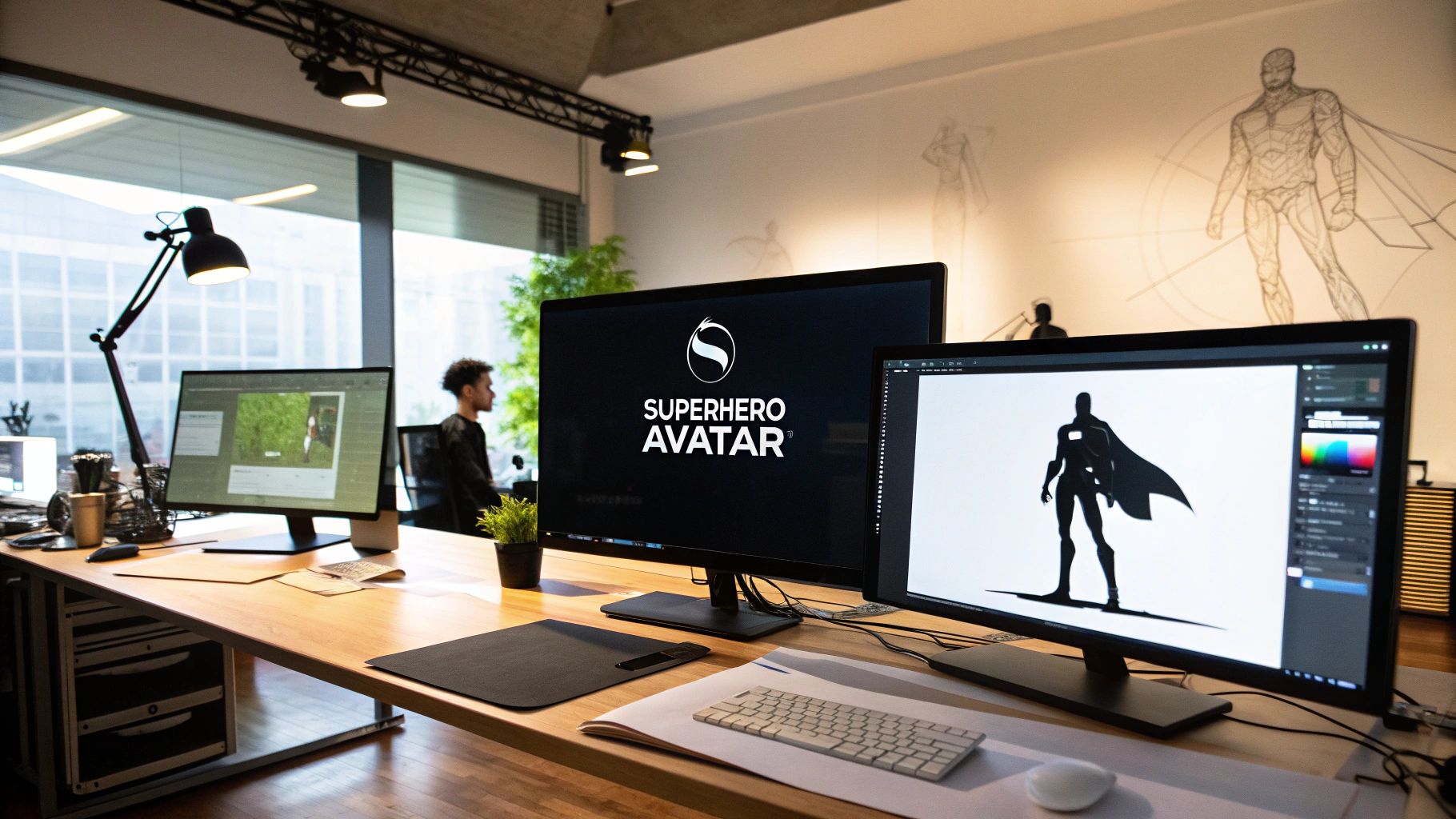
Ready to bring your own superhero to life? It’s a fun process that blends your imagination with some seriously cool AI tools, letting you turn that hero in your head—their powers, their look, their whole vibe—into a killer avatar you can use anywhere online.
How to Create a Superhero Avatar That Doesn't Look Generic
Forget those cookie-cutter character creators. We're diving deep into a process where you're in the driver's seat, taking a hero from a rough concept to a polished, professional-looking image. I'll walk you through exactly how it's done. A unique avatar is your digital signature, especially in crowded spaces like gaming, social media, and virtual worlds where making an impression is key.
A personalized avatar is so much more than a profile picture; it’s a piece of you in the digital realm. This is a big reason why the market for these tools is exploding. In fact, the 3D avatar creator market was already worth USD 572.3 million in 2023 and is expected to climb to an incredible USD 2,216.6 million by 2033. That growth is all about how vital custom avatars have become in VR, AR, and just about every online community.
Mapping Out the Creative Process
Building a memorable superhero avatar is part strategy, part pure creativity. It isn't just about mashing buttons and hoping for the best. It’s about making smart choices that layer on top of each other to create a character that feels real and looks amazing. This handy visual breaks down the core stages you'll go through.
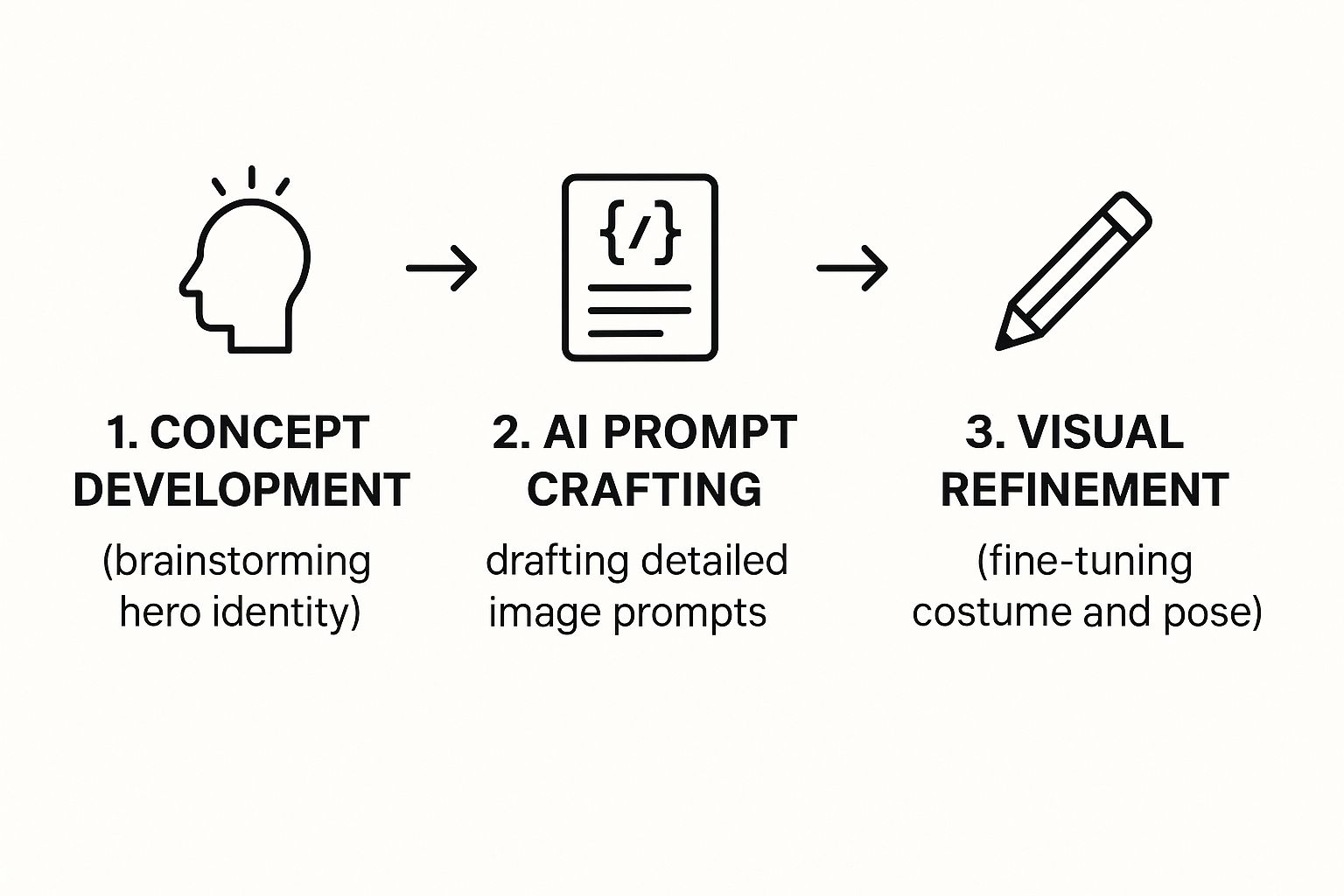
As you can see, a great avatar doesn't start with the AI—it starts with a solid idea. Each step logically follows the last, making sure the final image perfectly captures what you first envisioned.
To help you stay organized, here's a quick look at the main stages of creation.
Superhero Avatar Creation Stages at a Glance
This table summarizes the journey from initial idea to final render, giving you a clear roadmap of the creative process.
| Stage | Key Focus | Pro Tip |
|---|---|---|
| 1. Conceptualization | Defining the hero's identity, powers, and backstory. | Don't just think about what they look like; think about why they look that way. |
| 2. AI Prompting | Translating your concept into detailed, descriptive text for the AI. | Be specific! Use adjectives for materials, lighting, and mood. |
| 3. Generation & Iteration | Generating initial images and refining them through prompt adjustments. | Your first try is rarely your last. Tweak and regenerate to get closer to your vision. |
| 4. Posing & Expression | Choosing a pose and facial expression that convey personality. | A dynamic pose can tell a whole story in a single image. |
| 5. Final Rendering | Selecting the final settings for image quality and style. | Always render at the highest quality possible for the best detail and clarity. |
Keeping these stages in mind will help you approach the creation process with a clear plan, leading to a much better outcome.
The most impactful superhero avatars are born from a clear vision. By defining your hero's identity first, you give the AI a strong foundation to work with, resulting in more accurate and compelling visuals.
Of course, to get started, you need the right tool for the job. You'll want an AI-powered platform that's easy to use but powerful enough to turn your detailed ideas into high-quality art. Throughout this guide, I'll be using CreateInfluencers because it offers the flexibility and control we need to nail every step, from designing the perfect suit to setting an epic scene.
Building Your Hero's Core Concept and Identity
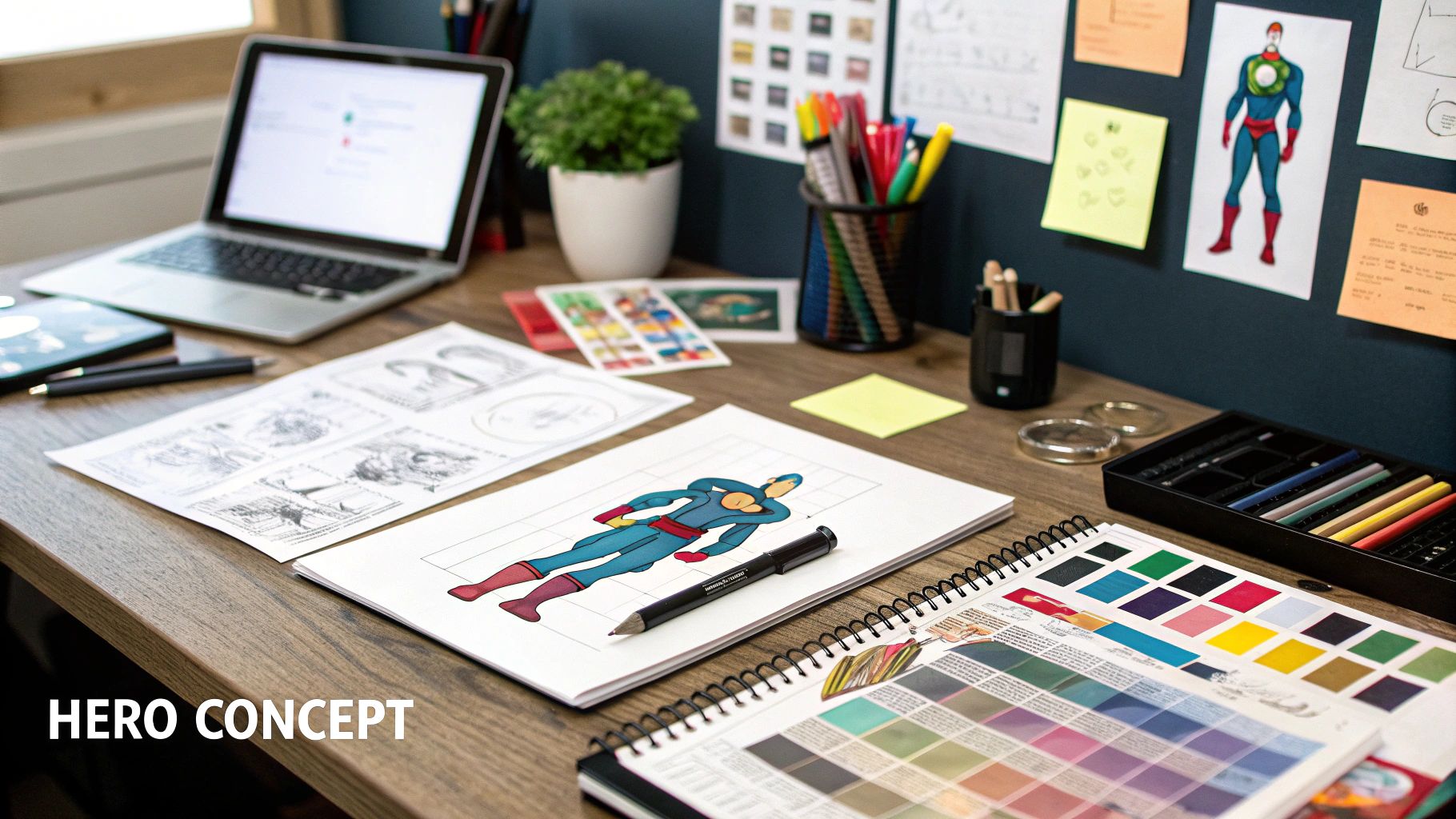
Before you even think about writing an AI prompt, the most important work happens right in your head. This is the conceptual phase, where you lay the groundwork that makes an avatar feel real and unforgettable. Trust me, without a solid identity, even the smartest AI tool will spit out something that looks and feels generic.
Start with the core of your hero: their power. Is it elemental control, psionic abilities, or just good old-fashioned brute strength? This one decision will have a massive ripple effect on their entire design. A pyrokinetic hero, for example, would probably have a costume made of flame-retardant materials and a warm color palette. A telepath, on the other hand, might have a sleek, minimalist design that hints at mental power, not physical prowess.
This initial idea is just the seed. A strong backstory and a clear personality are what separate a cool drawing from a truly compelling character.
Defining Your Hero's Aesthetic
Once you've nailed down the power set, it's time to think about the overall visual style. The aesthetic you choose will guide every single design decision you make from here on out, from the texture of their suit to the lighting in the final render.
Not sure where to start? Consider these popular styles:
- Classic Comic Book: We're talking bright primary colors, bold black outlines, and dynamic, action-packed poses. This style is perfect for a hero with a hopeful, straightforward personality.
- Gritty Modern Realism: Think muted color palettes, tactical gear, and battle-worn textures. This is the way to go for a darker, more complex character navigating a morally gray world.
- Sleek Cyberpunk: This look is all about neon highlights, chrome accents, and high-tech augmentations. It works incredibly well for heroes in a futuristic setting where the line between human and machine is blurred.
The style you pick should feel like a natural extension of your hero's world. To dig a little deeper, I'd recommend checking out this ultimate guide to character design fundamentals to really help define your hero's unique vibe.
The best superhero designs tell a story. Every single element, from the emblem on their chest to the scuffs on their boots, should reveal something about their history, personality, and powers.
Crafting a Backstory and Personality
With a power and a style in mind, it's time to add some depth. Answering just a few key questions can transform a flat concept into a three-dimensional character. This isn't about writing a novel; it's about creating a "creative brief" for yourself and, eventually, for the AI.
Try thinking through these prompts:
- Origin: How did they get their powers? Was it a freak accident, a divine gift, or something they trained for their whole life?
- Motivation: What makes them get up and be a hero every day? Is it a deep-seated sense of justice, a need for redemption, or something more personal?
- Flaws: What's their greatest weakness? A compelling hero is never perfect—their flaws are what make them relatable.
Having solid answers to these questions will make it infinitely easier to create a superhero avatar that feels genuine. For more inspiration on building characters and defining visual styles, you can always explore the tutorials over at our https://createinfluencers.com/guides.
Once you’ve gone through this process, you'll have a solid blueprint ready to bring your hero to life.
Mastering AI Prompts for Superhero Design
https://www.youtube.com/embed/bIxbpIwYTXI
Now that you have a solid concept for your hero, it’s time to bring that vision to life. The real secret to getting a stunning, professional-looking AI-generated image isn’t just the tool you use—it’s the quality of your text prompt.
Think of yourself as an art director giving instructions to a hyper-talented but very literal artist. If you just ask for "a superhero," you’ll get a generic, forgettable result. But when you give specific, evocative instructions, you can truly create a superhero avatar that feels like it was pulled straight from your imagination.
From Vague Ideas to Vivid Images
Specificity is everything. A weak prompt gives the AI too much room for interpretation, and it will likely fall back on clichés. Let's walk through how to build a prompt that delivers a powerful visual.
You might start with a simple idea: "a female superhero." That's a decent starting point, but we can do so much better. The key is to layer in details that paint a clear picture.
- Evocative Adjectives: Instead of just saying "armor," what kind of armor is it? Is it "phosphorescent," "battle-scarred," or maybe "ornate ceremonial"? Each word changes the story.
- Action Verbs: Don't let your hero just stand there. Is she "levitating," "crouching on a gargoyle," or "unleashing a torrent of cosmic energy"? Action creates dynamism.
- Art Style & Lighting: This is where you set the mood. You can completely transform the final image with terms like "cinematic lighting," "cel-shaded," "hyper-realistic," or "dramatic chiaroscuro."
Watch how our simple idea evolves. The prompt goes from a vague request to a rich, detailed command: "Full-body shot of a female superhero with phosphorescent armor, levitating amidst cosmic energy, dramatic chiaroscuro lighting, art by Greg Rutkowski." Now that gives the AI something incredible to work with.
The best AI prompts are a cocktail of specific nouns, powerful adjectives, and descriptive verbs. Every word you add is another brushstroke, guiding the AI closer to the masterpiece in your head.
This kind of creative control is driving huge growth in AI-powered design. In fact, the AI avatar market is on a trajectory to explode from USD 0.80 billion in 2025 to a staggering USD 5.93 billion by 2032. This boom is all thanks to AI getting better at understanding natural language and computer vision, making these digital personas feel more real and interactive every day.
Using Negative Prompts for Creative Control
Just as important as telling the AI what you want is telling it what you don’t want. This is where negative prompts become your best friend. They are simply keywords you add to instruct the AI to exclude certain elements from the final image, giving you a powerful layer of fine-tuning.
Ever get an image with extra fingers, a blurry face, or random text artifacts? A negative prompt is the fix.
Here are a few common ones I use all the time:
ugly, deformed, poorly drawn hands, extra limbsblurry, grainy, low-resolution, watermark, signaturetext, words, letters, boring, generic, flat
Using negative prompts is a game-changer for cleaning up your results and nudging the AI toward a more polished outcome. It's an essential skill for mastering the art of the prompt.
Of course, a great design goes beyond just the prompt. Understanding fundamentals like using AI and color theory to define a character's color palette can really elevate your hero's final look. For more deep dives into prompting techniques and other AI art tips, be sure to check out the articles on the CreateInfluencers blog.
Designing an Iconic Costume and Gear
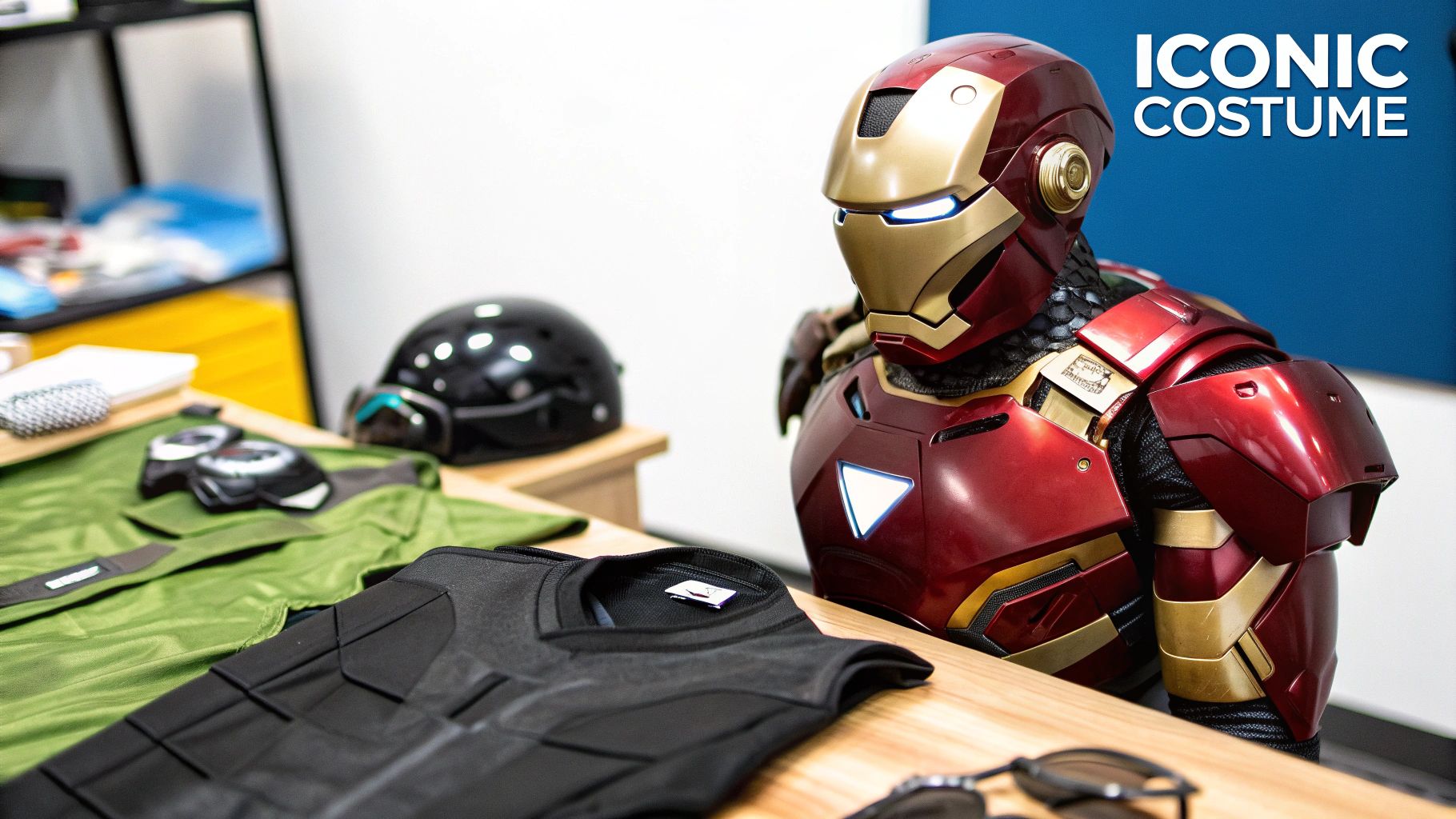
Let's be honest, a hero's costume is their brand. It tells you everything you need to know about them before they’ve even thrown a punch. When you get down to it, designing the costume is how you turn all those ideas about your hero's powers and personality into something people can actually see.
The first thing I always think about is the material. Your prompt is the perfect place to specify textures that give clues about where your hero comes from or what they can do. Are they covered in a "high-tech nano-weave suit with glowing circuitry"? That immediately screams advanced science. Or maybe they're wearing "battle-worn leather and mythic metal plates," which points to a completely different, almost fantasy-like origin.
Every single choice tells a part of the story. If your hero controls fire, you could give them a suit made from "obsidian plates" or even a "material that smolders with internal embers." Little details like these are what make a design stick in someone's mind.
Refining Key Costume Elements
Once you have the base material down, it’s time to add the defining accessories. These are the pieces that create that unique silhouette and often become the most memorable parts of a hero's look. You need to call these out specifically in your prompts to make sure they get the focus they deserve.
From my experience, it helps to concentrate on these key areas:
- Emblems and Symbols: Don't just ask for a generic symbol. Get specific. Try prompting for an "embossed silver phoenix emblem on the chest" or a "glowing, arcane rune on the shoulder guard." The more detail, the better.
- Capes and Cloaks: A cape just adds instant drama. Is it a "tattered, flowing red cape, ripped from battle," or something more elegant like a "majestic cape woven from starlight"?
- Helmets and Masks: A helmet can signal anything from pure intimidation to high-tech protection. You could ask for a "sleek, aerodynamic helmet with a holographic visor" or go old-school with a "forged iron helmet with ornate engravings."
- Gauntlets and Boots: These pieces often hint at how a hero fights. Are they wearing "heavy, armored gauntlets for blocking attacks" or "lightweight, silent boots for stealth"?
When you break the design down like this, you’re feeding the AI much clearer instructions. The result is almost always a more detailed and intentional-looking character.
The most legendary superhero designs feel both purposeful and personal. Every piece of gear, from the style of their boots to the emblem on their belt, should feel like a deliberate choice that reinforces who they are.
Choosing a Powerful Color Palette
Color is pure emotion. It sets the mood in a split second and screams personality. It’s pretty intuitive—a hero with ice powers is going to look great in blues, whites, and silvers. A character tied to nature will probably rock greens and earthy browns.
When you're writing your prompts, use these associations. For a mysterious, stealthy type, I'd specify "a muted color palette of charcoal grey, deep navy, and matte black." If you're going for someone bright and full of energy, you could ask for "a primary color scheme of bold reds and yellows with crisp white accents."
This is the final step that ties it all together. When the materials, the gear, and the colors all work in harmony, you end up with a superhero avatar that’s not just cool, but truly unforgettable.
Perfecting Poses, Expressions, and Backgrounds
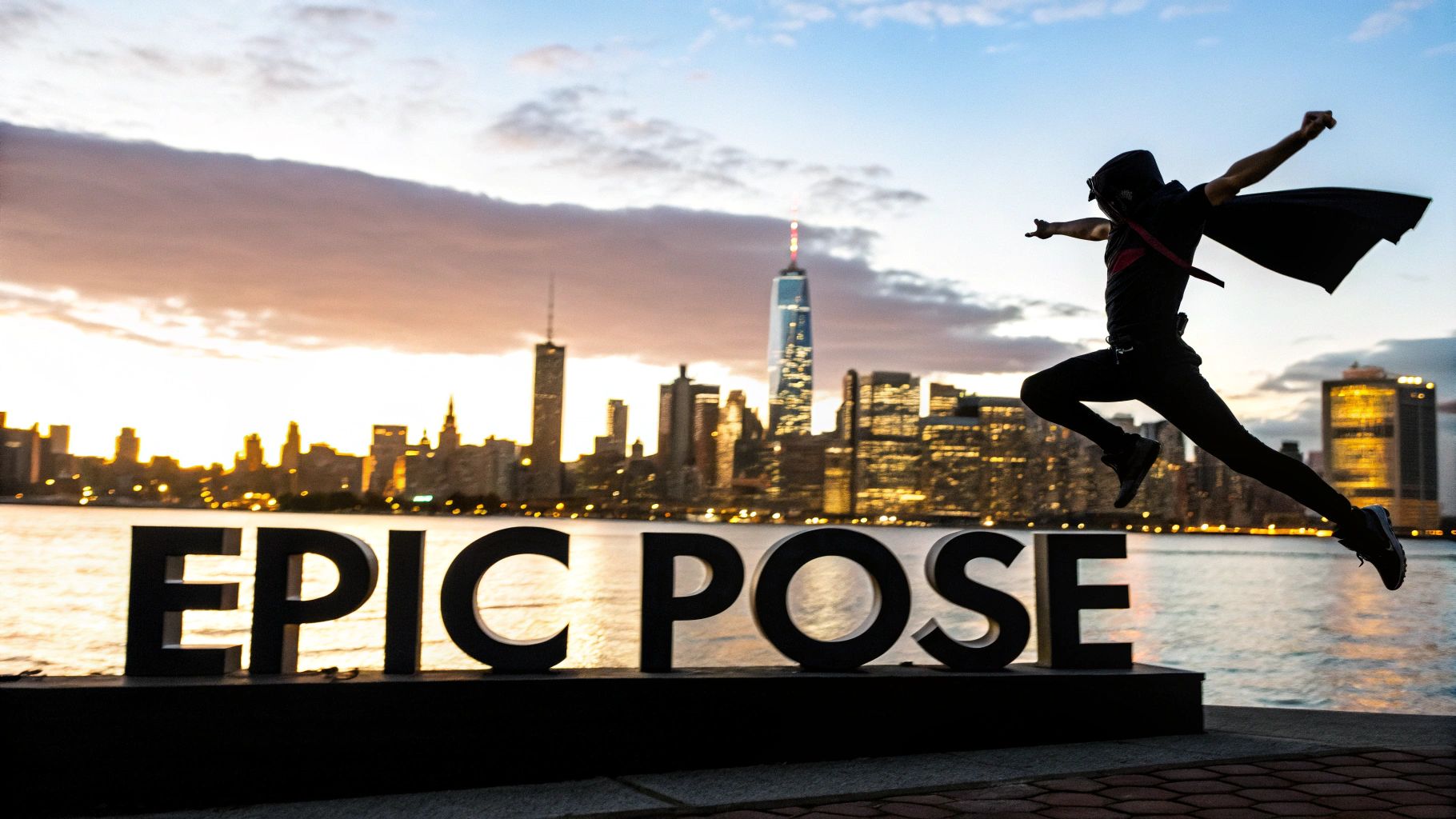
Okay, you've designed a killer costume. Now for the fun part: bringing your hero to life. A static drawing is fine, but a dynamic pose, a powerful expression, and the right background—that's what tells a story. This is the stage where you go from a cool concept to a poster-worthy final image.
The pose is your number one tool for showing off personality without a single word. Don't just prompt for a "standing pose." Think about who your hero is.
Is they an agile fighter? Try action-packed phrases like "crouching on a rooftop gargoyle, ready to pounce" or "mid-air, landing gracefully." For a powerhouse character, you might go with "bracing for impact, energy crackling around fists" or "standing defiantly amidst rubble." These details push the AI to create a scene that feels charged with energy, which is exactly what you need when you want to create a superhero avatar that grabs attention.
Capturing Personality Through Expression
Just as crucial as the pose is the look on your hero's face. A blank stare can make even the most incredible design feel empty. The good news is that you can inject a ton of personality with just a few words in your prompt.
Here are a few ideas to get you started:
- For confidence: "A confident smirk," "a knowing grin," or "a calm, determined expression."
- For intensity: "A focused grimace," "glowing eyes filled with power," or "a battle-hardened scowl."
- For heroism: "A hopeful, inspiring gaze," or "a look of quiet resolve."
Now, combine these with your pose. Imagine "crouching on a rooftop gargoyle" paired with "a focused grimace"—that’s a different hero entirely than the same pose with "a confident smirk." One is hunting, the other is just showing off.
The best superhero portraits make you feel something. The right combination of pose and expression can convey a character's entire backstory and motivation in a single, powerful glance.
Setting the Scene with a Powerful Background
The background is the final piece of the puzzle. It adds context and dials up the mood. Is your hero protecting a gleaming futuristic metropolis or stalking through a forgotten wasteland? The environment is what grounds your character in their world.
Get specific. Don't just ask for a "city." Describe it. Is it a "neon-drenched cyberpunk cityscape at night, rain-slicked streets reflecting the glowing advertisements"? Or maybe a "war-torn city in ruins, smoke rising from crumbling buildings under an ominous red sky."
This kind of detail is more important than ever. The digital avatar market is projected to explode from USD 29.06 billion in 2024 to a massive USD 652.29 billion by 2032, all fueled by the need for unique online personas. You can read more about the incredible expansion of the digital avatar market and its future trends. By really nailing the scene composition, you’re making sure your hero doesn't just exist but truly stands out in this crowded new universe.
Your Top Superhero Avatar Questions, Answered
Jumping into AI tools to create a superhero avatar is exciting, but it’s natural to have a few questions. I see the same ones pop up all the time. Getting these sorted out early on can save you a ton of headaches and help you get the exact hero you're envisioning. Let's walk through the most common sticking points.
How Do I Keep My Character Looking the Same?
This is easily the biggest challenge. You finally nail the perfect look for your hero, but then you try to put them in a different scene, and suddenly they're a completely different person. Frustrating, right?
The secret is to give the AI a very specific "character seed" that you can reuse in every prompt. Think of it as your character's unique DNA. Instead of just saying "a male superhero," you lock in the details.
For example, a solid seed prompt would be something like: "a male superhero, Jax Kori, with short black hair, a jagged scar over his left eye, wearing a crimson and charcoal gray suit with a silver phoenix emblem." By using this exact description as the foundation for every new image you generate, you're constantly reminding the AI who your character is. This consistency is what makes your hero feel real and recognizable across different images.
How Can I Make My Hero Actually Look Unique?
To avoid creating a hero that looks like they came straight from a generic superhero generator, you have to get creative with your combinations. Don't just stick to one genre. Mash things up! Mix a classic fantasy vibe with a sci-fi twist, or maybe give a character in historical armor some futuristic tech.
Specificity is your most powerful tool here. Instead of just "a cape," try describing it as "a tattered cape woven from cosmic starlight." These little details force the AI to think outside the box and move beyond its standard outputs.
Another pro tip I've picked up is to reference less common art styles. Everyone uses "comic book style." It works, but to stand out, try adding modifiers like "Art Nouveau linework" or "Baroque lighting." The results can be stunningly original.
I've found that the most memorable avatars always come from a fusion of unexpected ideas. Don't be afraid to combine genres and styles to create a hero that nobody has seen before. A unique concept is the foundation for a standout design.
What Are My Rights to the Images I Create?
This one is incredibly important, and the short answer is: it depends on the AI platform's terms of service. With a tool like CreateInfluencers, you generally have broad rights to use your creations for both personal and commercial projects. Still, it’s always a good idea to double-check the fine print.
When you're looking at the terms, keep an eye out for these key points:
- Commercial Use: Are you clear to use the avatar for things you might make money from, like social media content or a webcomic?
- Ownership: Do you actually own the final image, or does the platform just give you a license to use it?
- Attribution: Do you need to give credit to the AI tool whenever you post the image?
Getting clarity on these details upfront gives you the peace of mind to use your awesome new superhero anywhere you want, without worrying about legal issues later on.
Ready to stop guessing and start designing a legendary hero? With CreateInfluencers, you can bring your most ambitious ideas to life with powerful, intuitive AI tools. Start creating for free today and see for yourself.